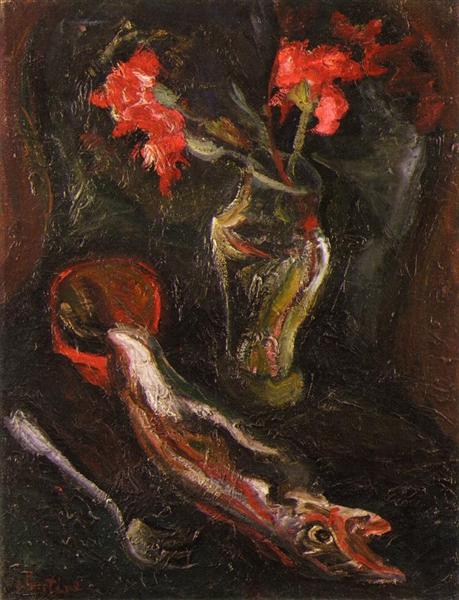Kuvaus
Chaim Soutine, a leading exponent of Expressionism and one of the precursors of modern art, shows himself in his work "Flowers and Fish" (1919) as a master in the fusion of elements that seem dissonant at first sight, but which in their treatment become a harmonious dialogue. The painting captures the essence of his characteristic style, which focuses on emotional intensity and the bold use of color, aspects that are key to understanding his artistic production.
In “Flowers and Fish,” the composition is organized around a vase housing a rich floral display, accentuated by the presence of a fish, lying on the surface. The shape of the vase seems to take on an almost sculptural presence, evoking a strong sense of three-dimensionality in contrast to the flat background. Soutine, true to his style, does not seek realistic representation, but instead employs a gestural brushstroke that conveys fervour and vibrancy. The vibrant colors of the vase and flowers contrast sharply with the more somber and earthy textures of the fish, creating a visual tension that leaves the viewer contemplating the relationships between the elements depicted.
Colour is one of the undisputed protagonists of this work. The flowers are presented in an exuberant palette, where red, yellow and pink tones respond to his desire for emotional expression rather than a faithful representation of nature. Soutine uses these colours masterfully, applying them in dense layers that provide extreme visual richness and an almost tactile sensation to the petals. The fish, meanwhile, with its cooler and more muted nuances, adds a dose of reality and unites the subject of still life art with a viscerality that only he could provide.
In the context of Soutine's work, Flowers and Fish is part of a series of still lifes that evoke his fondness for still lifes and his ability to transform the everyday object into a profound sensorial experience. Soutine was influenced by his life in Paris and his interaction with other avant-garde artists of his time, as well as by the legacy of the Dutch masters. However, his work is characterized by a singularity that sets him apart from his contemporaries, due to his fervent and almost tumultuous approach to painting.
It is no small fact that Soutine struggled with internal questions of identity and self-expression throughout her career. This emotional, personal, and even tormented aspect is palpable in all of her works, and “Flowers and Fish” is no exception. The choice of materials, the dislocation of form, and the vibrant color palette invite a reflection on the duality of life and death, pleasure and pain, elements that are inescapably intertwined in the human experience and which Soutine captures with heartbreaking subtlety.
The painting reminds us of Soutine's place in art history, beyond the confines of his time. His bold application of color and ability to inject emotional meaning into still life have earned him a prominent place among the greats of modern art. Through "Flowers and Fish," one can see a man who doesn't just paint what he sees, but what he feels, capturing the essence of his reality and the intrinsic connections between elements of nature that are often overlooked.
KUADROS ©, a famous painting on your wall.
Hand-made oil painting reproductions, with the quality of professional artists and the distinctive seal of KUADROS ©.
Painting reproduction service with satisfaction guarantee. If you are not completely satisfied with the replica of your painting, we will refund 100% of your money.

